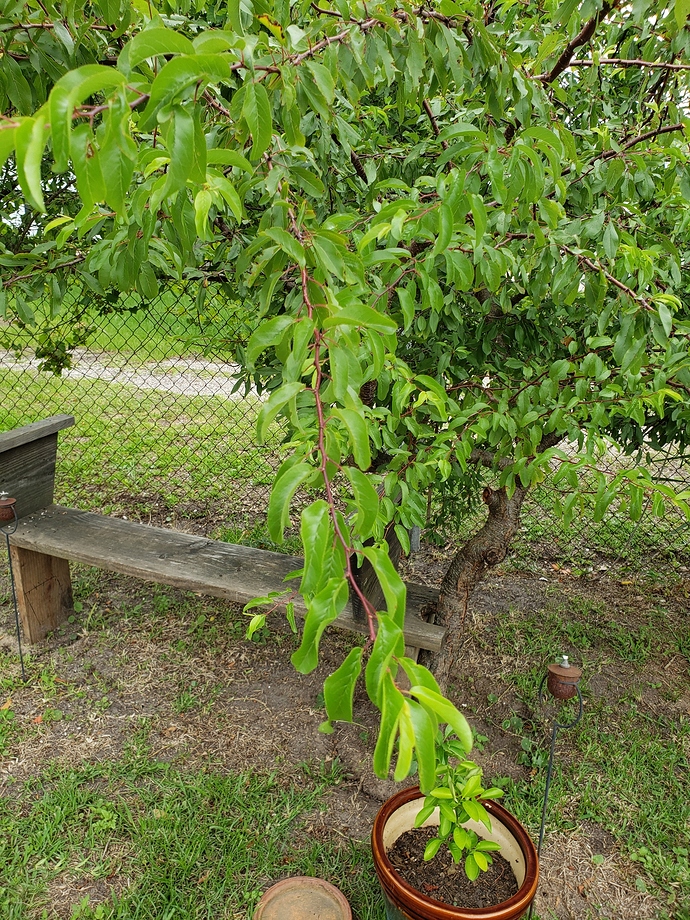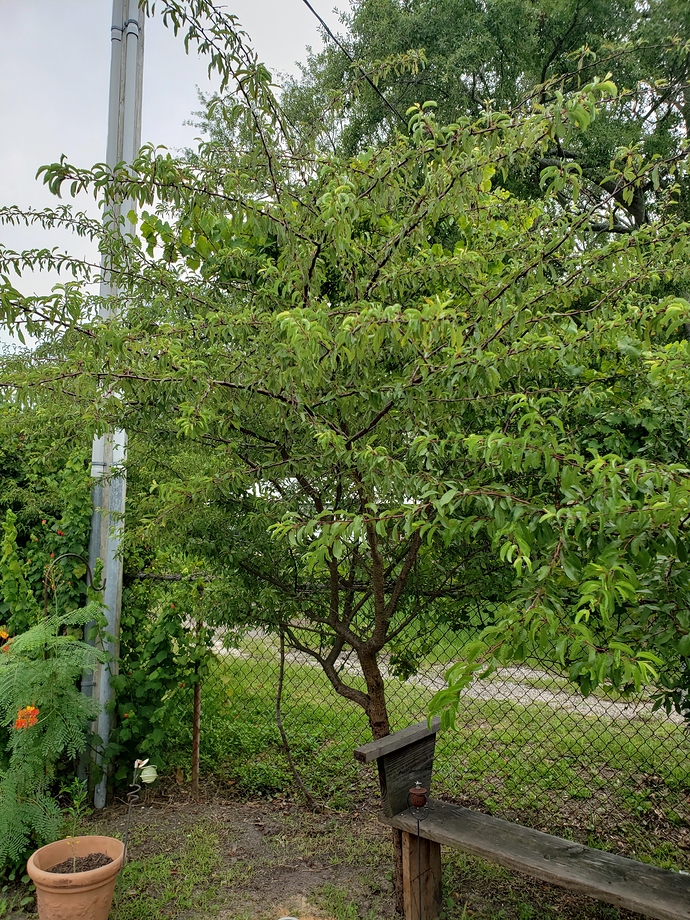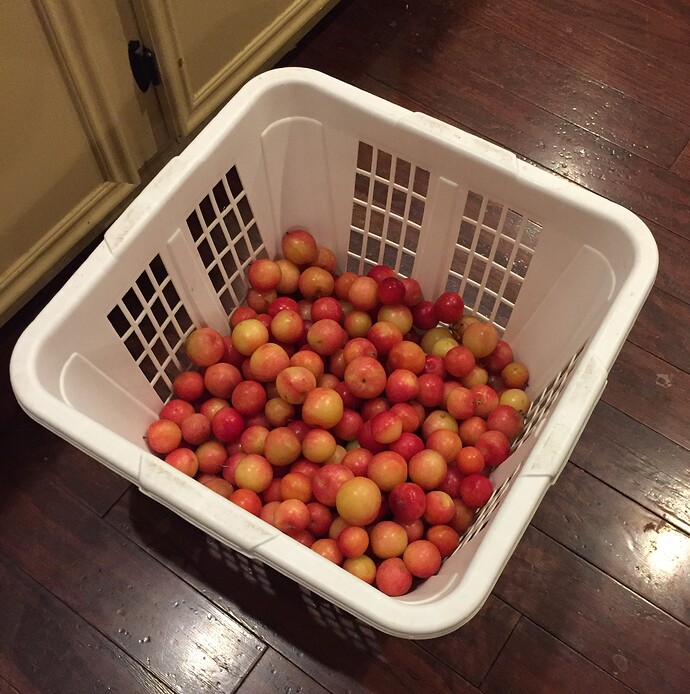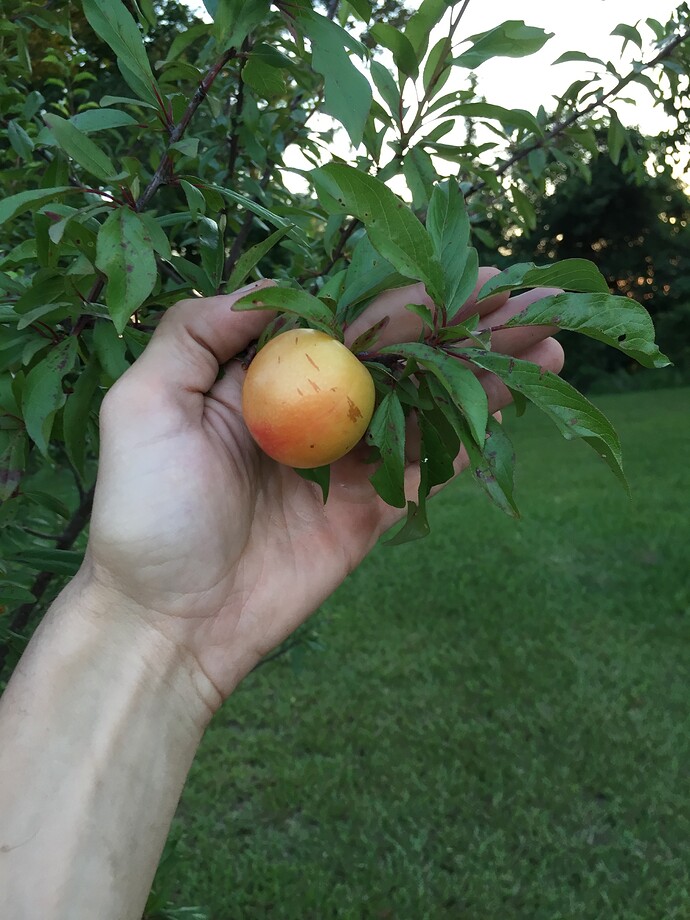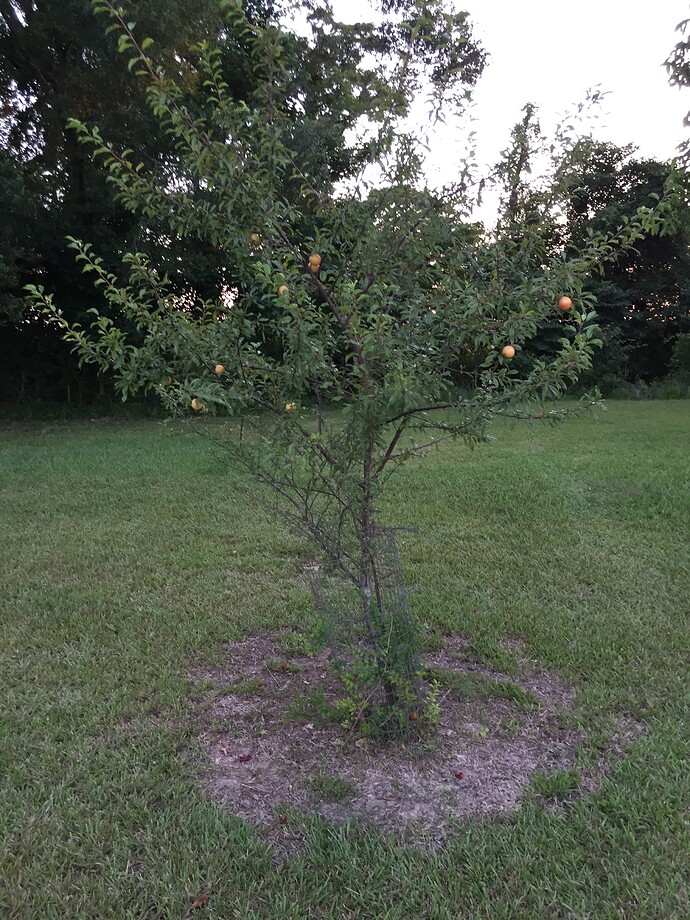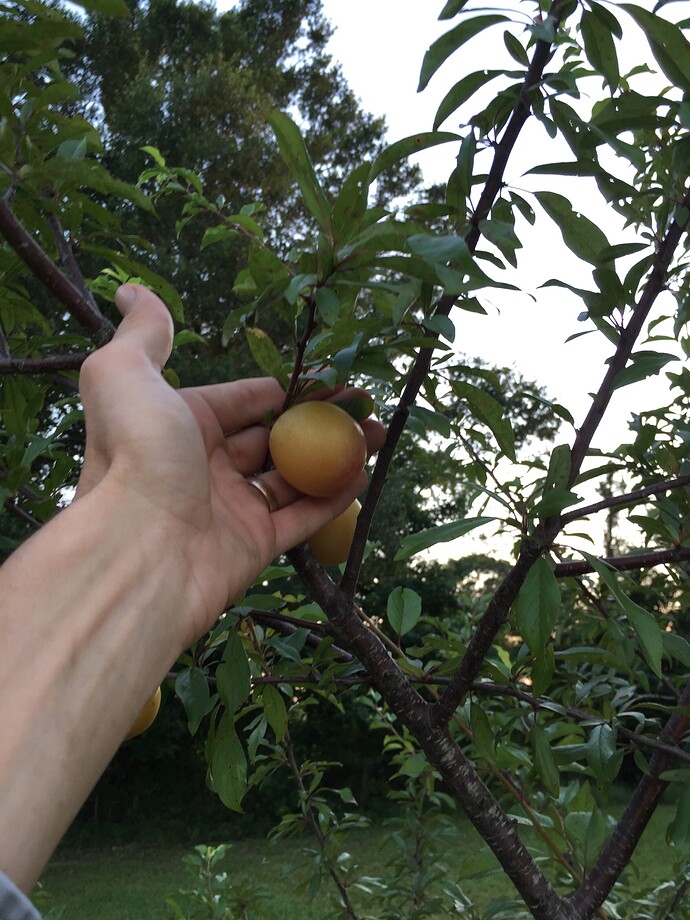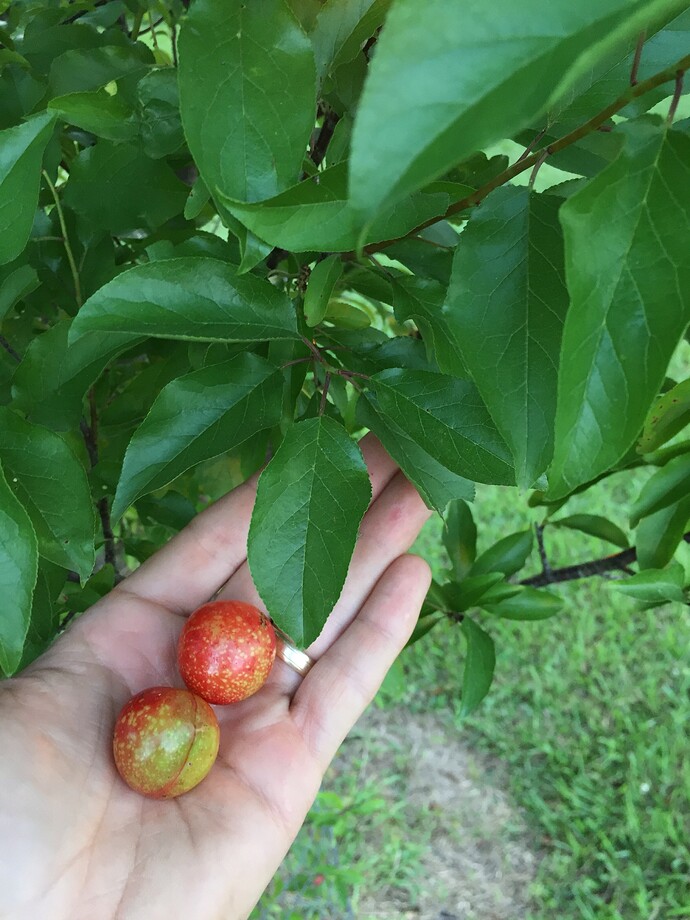Signs, yes, but nothing definitive. Last year (3rd in the ground) it had a few blooms but set no fruit. This year it bloomed heavily and set about 35-40 fruit. The pollination situation is good but not ideal, with a purple leafed, a japanese seedling, toole’s heirloom (which bloomed lightly), and two native chickasaws close by. A grafted Odom is also near and will probably bloom for the first time next year. I’ll be transplanting a Guthrie and a Robusto to the same location as soon as possible. It appears that Robusto is my best pollinator out of all of them.
The red leaf plum seedling looks very similar to my Hollywood plum grafts. It would be great if you have an edible ornamental that is adapted to your climate. I hope you get a good harvest without sour/bitter skin.
Got a friend in Pascagoula Mississippi dug up a small wild plum in his yard and gave me today. The plums have just been picked. He had some in refrigerator, they were bright red while more mature plums were dark red. They were small, about 1 inch or so in diameter. They were delicious but the skin was bitter and thick. Made me want to spit the skin out. Inside was a dark yellow and very juicy. He found the trees growing along side the road, dug them up and planted in his yard. Uploaded pictures of his trees. Those trunks are about 8 inches in diameter and they are about 12 ft high. They sucker a good bit, he’s always given them away. He said everyone calls them a possum plum cause the possums are always in the trees eating plums. Doesn’t know real name.
IAW with this page i recieved a chickasaw plum tree. The fruit in the picture matches what I saw and ate. The leaves match exactly in the description.
I got a Guthrie from them [Mail Order Natives ] and still waiting for a Odom which their out of stock and have been for a while. I also have a Byrongold Plum from JFE and they say it will pollinate the Guthries. We’ll see. If you know of any others that will pollinate Guthrie please let me know. I don’t want to wait years later to discover Brrongold ain’t doing the job. Rumors have gulf beauty and gulfrose might pollinate Guthrie. I guess it’s worth a try.
Friend of mine gave me some Gulfbeauty and Gulfrose sion wood. I’ll graft them in soon as it gets warmer.
That Chickasaw I got died so its not available for pollination, lol
A late freeze wiped out most of my plums and peaches this year. The Toole’s heirloom grafted to my native chickasaw set very well, but the one on it’s own roots about half a mile away, was covered with blooms and has only a handful of fruit. About 1 degree colder there than where the graft is. Guthrie, Odum, Robusto, the native chickasaw, the red-leafed seedling (which had set a lot of fruit) all have only a handful left.
My 2 Chickasaw plum seedling are blooming for the first time. I am trying to pollinate them with Flavor Grenade, Toka, and Candy Heart. I have no idea if they will set fruit, but this warm/dry weather can’t hurt.
I’m sorry for your loss. I am encouraged to hear that the purple Guthrie seedling tried to bare a large crop even if the little plums got yacked by frost. That bodes well for the future. I’ve taken to calling the strain “drag queen”. The one that I have is really turning into a beauty. Other than having purple leaves, it looks less like a hybrid to me than Guthrie does. Anyway, it’s quite striking, and if it turns out to be productive and disease resistant, it should turn into a big seller for the home nursery trade. I can tell that this is going to be a very pretty tree.
Marcus Toole
My guess is that if the two seedlings bloom together, they will pollinate each other. If they bloom with the others they might improve the productivity of those other plums. Let us know if they all bloom together. That would be good information for a lot of people I suspect.
I put one in the back, and pollinated it with Candy Heart pluerry and White Gold cherry. The one in the front got Flavor Grenade and Toka. Candy Heart and Flavor Grenade are new trees, so the blooms happen to overlap. Toka is a 1 year old graft on M-2624, but still produced flowers with a short overlap. No telling if a larger Toka will overlap in a normal year. They seem well timed to bloom with White Gold cherry, but I would be very lucky to get a viable seed. I did not emasculate, so I wouldn’t be sure of the paternity until they germinate.
It turns out I was wrong about the fruit set this year. Robusto actually set well, but all of the others except that one Toole’s heirloom graft were pathetic. Drag queen had about 10 fruit from the hundreds of blooms, and those have all been taken by birds/squirrels/raccoons/possums- I think that’s a downside of having a fruit that starts out red, and ripens to even darker burgundy.
Robusto has been a clear winner for several years. The tree is vigorous, the plum curculio don’t seem to like it nearly as well as Guthrie and Odom right next to it, and neither do the aphids. It has good size and apparently not too bothered by late frosts. I like the flavor about as well as Odom (also zapped by the late frost), but not as much as Guthrie or Toole’s heirloom.
Here’s the plum story so far this year. Mariana (probably 2024) made over 200 pounds of plums this year, and I made nearly $400 off of them. Robusto had a good crop, big plums as always. It’s an OK plum but I like Mariana and Toole’s Heirloom better. I have a medium size Toole’s Heirloom crop beginning to ripen now. Made a few Guthrie plums this year. Pollination was not great on that one. There was not good overlap in blooming with any of the wild plums which it seems to need. It overlapped well with another yellow chickasaw cultivar which we are calling Sonny’s Yellow, but neither tree set fruit very well. The fruit of the two trees are very similar to each other, but the flowers look very different, so I’m confident Sonny’s Yellow is not just an unidentified Guthrie. It’s the Sonny’s Yellow’s first bloom, so the issue may be immaturity and that it did not have a huge bloom. The three plums that I did get on Sonny’s yellow are averaging larger than the Guthrie plums. Non of them have ripened yet, and I’m guessing it’s going to be a later ripening variety in general.
My two year old (third season) seedling from Robusto made one plum. I colored up last week but was not even slightly ripe when I picked it. It’s a big red fruit like Robusto, but it’s even more tart than Robusto when not fully ripe. It didn’t have any bitterness or astringency which means it will probably be pretty good when ripe. We will see what it does next year.
Another Chickasaw plum which I’m calling Ridgeland has seven plums on it this year. They are huge, nearly Robusto size. They are peach to lemon shaped with a distinct nipple on the bottom. It’s looking like most of them will ripen to a golden yellow with a reddish blush on one side. They are better than Robusto in the semi ripe stage, so I have high hopes for this one being very, very good. It’s looking like they are going to ripen with or a little later than Toole’s Heirloom but not as late as Odom.
The Excelsior Asian X American plum hybrid made a few plums this year. They are super early, super sweet, good size and even earlier season than Mariana. It seems to be disease resistant enough for my climate. We got an unusually large number of chilling hours this year, so the jury is still out as to whether it is really low chill enough for Statesboro Georgia. My only complaint about it is that every one of the pits were split which means it would be easy to break a tooth on a bit of pit shell if you aren’t careful when eating them.
The Sprite Cherry Plum made this year as the the limb of AU Cherry grafted into a Robusto tree. The wild hog plums that I ordinarily use to pollinize Mariana did not bloom this year, but the cherry plums did the job. Sprite plums turn dark long before they ripen, and yes, the critters are really targeting them. They have a wonderful flavor when soft ripe as do the AU Cherry plums.
NC McKibben bloomed late this year. It did not overlap with any wild plums but did overlap with the Robusto scion grafted into it. That Robusto scion blooms late as well. (Root stock definitely seems to effect bloom time in plums.) It overlapped some with Guthrie and Sonny’s Yellow. The Robusto scion was as poorly pollinated as Guthrie and Sonny’s Yellow. McKibben did not set any fruit at all. I’m completely convinced that non of the Chickasaw cultivars or Chickasaw hybrids will set fruit well unless there is a wild chickasaw plum present for pollination. Cheers!
Great to hear a plum report. In south Louisiana I had a good crop of plums. Guthrie finished about 10 days ago with a high number of fruit that were smaller in size than most years. Odom has put on prolifically and am still picking those.
A couple new developments…
I got a random seedling from a lady at an antique sale o few years ago. It has grown into a pretty tree and produced for the first time this year, a large yellow Chickasaw, as large or slightly larger than my largest Odoms. It has not started ripening yet but Sunday one started feeling soft as it was starting to blush. Im excited about this tree’s later ripening am looking forward to watching it over the next few years.
Also, this small speckled looking plum from a tree labeled wild goose. It’s leaf is noticeably much wider than any Chickasaw I have. With that said it is next to two other plums from the same batch of “wild goose” seedlings and it’s lead is different and much larger than the other two wild goose seedlings.
I guess the extra cold winter
This has been a good read. My Guthrie has fruited for the first time in its second year after planting. My Odom was planted at the same time has not. My Byrongold which is planted next to my Guthrie bloomed but didn’t set any fruit. My Scarlet Beauty has fruited in it’s first year with 8 nice size plums, hope its a winner. I’ve nothing but good comments regarding Scarlet Beauty, fingers crossed. My Gulf Beauty which is in it’s first year put on a couple blooms but no fruit, hopefully this will be a winner also. I planted to suckers of Paradise plum last year, they grew to 8 ft tall immediately but didn’t bloom in its first year, fast grower for sure.
Terrible year for production this year, as for the 1st time in 7 or 8 years of a late frost wiped out almost every plum on Guthrie, Odom, Robusto, Toole’s Heirloom, unimproved wild, and red leafed seedling. The red leafed seedling has maybe 40 plums, Odom 10, Guthrie 1, and the rest none. All the trees continue to be extremely vigorous, with little to no black knot, and graft well to wild Chickasaw rootstock and prunus cerasifera/myroblan. A favorite of plum curculio, but they prefer Odom over the others, and for some reason year after year green aphids prefer Guthrie. I have a Guthrie whose limbs touch Odom and Robusto. The Guthrie is covered with aphids, the Robusto and Odom have none. Same situation last year and the year before.
This fruit looks a lot like some wild goose plums that grew in a thicket where I grew up. A few years ago I visited the site but the trees were no longer living. Three years ago I order a couple wild goose from a nursery and planted them and now they are about 12’ tall and should be fruiting this spring. (I hope they have similar fruits).
Dennis
Kent, wa
hello everyone.
this forum has come up for me a few times in my search engine when i attempt to search for obscure plants and such.
today, and after coming across this awesome thread on wild/chickasaw plums, i decided it was time to join.
i have been propagating various eastern US wild plums species for about 10 years now, though i have only one named cultivar at this time. it is one from Larry Stephenson (McKibben?).
i would love to get as many of the named varieties as i can get my hands on. and i have less interest in grafts. i want to be able to easily propagate the named varieties from root suckers, so that would be prefered.
anyone willing to help me out? i run a bare root nursery and have lots i can offer in trade, though this time of year i am out of many things.
looking forward to hearing back from y’all.
be well.
Hi Alexander,
Welcome to the site.
I have collected an assortment of seed and cuttings from various sources and members around the country. I am trying three methods to propagate them: by seed, by grafting and by rooting the cuttings. Locally I have four volunteer natives that are unnamed: cherry plum, a red plum, a green gage, and one that resembles Stanley fruit. I have one area where the suckers proliferate, but they are not producing fruit so any suckers I could give your would be one of a possible three varieties. I have found that getting the seeds to germinate takes a lot of patience, but rooting from cuttings seems to be the fastest and most reliable way of getting an individual rootstock that will reproduce predictable fruit variety.
Dennis
Kent, Wa
I cannot offer up what doesn’t belong to me, but I recently discovered that the farm-type property that my friend owns on the Alabama-Georgia border has several groupings of what appear to be different varieties of native plum trees. I did a physical survey of all of the tree line outer perimeter in January, and plan to revisit and finish the interior islands, and then monitor the trees for fruiting. He indicated that there should be no issue with me collecting some plant specimens from him.
@AlexanderMeander, where are you in 7b?
One question I have for those growing natives? Is the role of thornes strictly only defense, or do thornes play a different role related to pollination, male or female characteristics? Among my volunteers here some have thornes, other do not and so far my observations have not arrived at a role other than defense. Any insight welcome
Dennis
Kent, wa
